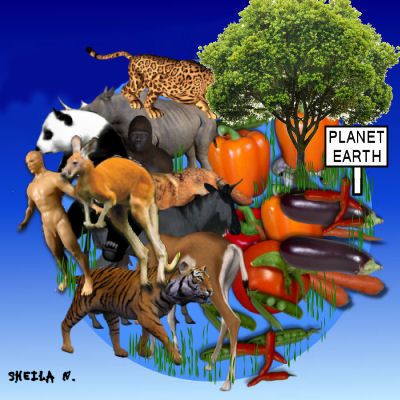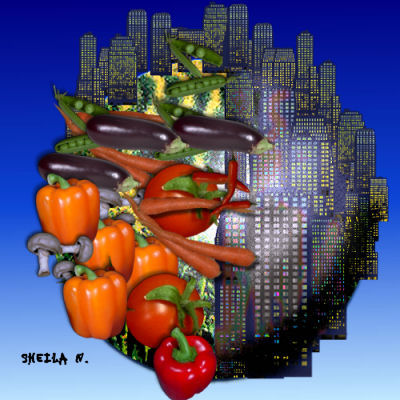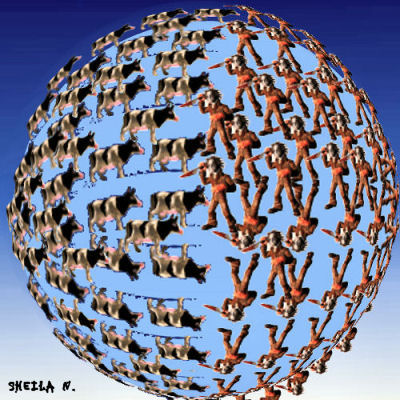

A study by researchers at Rockefeller University in New York that found we're using more agriculture now than we ever still claims there's going to be fewer of us at some point. It's just not a lack of available farmland or food that's going to kill us. Jesse Ausebel explains that while the common perception is that meeting humanity’s food needs is the task of farmers, there are many other players, including those of us who can choose what to eat and how many children to have. It's a denial of Malthus' warnings.
See also: USDA agricultural census program is a covert surveillance operation to compile government database of food and farm assets of 27 March 2013 - Ed


A study by researchers at Rockefeller University in New York that found we're using more agriculture now than we ever still claims there's going to be fewer of us at some point. It's just not a lack of available farmland or food that's going to kill us. Jesse Ausebel explains that while the common perception is that meeting humanity’s food needs is the task of farmers, there are many other players, including those of us who can choose what to eat and how many children to have. It's a denial of Malthus' warnings.

Earth has hit 'peak farmland,' new study says.
Researchers at Rockefeller University say crops will need less room to grow by 2060. But they leave out climate change and the debate over genetically modified food.
A study by researchers at Rockefeller University in New York that found we're using more agriculture now than we ever will still says there's going to be fewer of us at some point. It's just not a lack of available farmland or food that's going to kill us.
Jesse Ausubel, the director of the Program for the Human Environment at Rockefeller University, told Reuters that declining population growth and increased crop production will decrease the amount of necessary farmland by 10% and return an area of land 2 1/2 times the size of France to its natural state by 2060. On the contrary, a June 2012 report by the UN's Food and Agricultural Organization (FAO), says that an extra net 70 million hectares of land worldwide would have to be cultivated in 2050 compared to now: "Land and water resources are now much more stressed than in the past and are becoming scarcer," it says, referring to factors such as soil degradation and salinisation.

"We believe that humanity has reached peak farmland, and that a large net global restoration of land to nature is ready to begin," Ausubel wrote in the journal Population and Development Review. "Happily, the cause is not exhaustion of arable land, as many had feared, but rather moderation of population and tastes and ingenuity of farmers."
Ausubel and his co-authors optimistically see a reasonable prospect for conserving, and restoring, forests and other stressed terrestrial ecosystems even as humanity exerts an ever greater influence on the planet.
He explains that while the common perception is that meeting humanity’s food needs is the task of farmers, there are many other players, including those of us who can choose what to eat and how many children to have:
[T]he main actors are parents changing population, workers changing affluence, consumers changing the diet (more or less calories, more or less meat) and also the portion of crops entering the food supply (corn can fuel people or cars), and farmers changing the crop production per hectare of cropland (yield).
Scientists see promise for people and nature in peak farmland
It's said that changing diets is harder than changing religion! It assumes that more will be created from less. Nature has natural limits and can't be manipulated.
Slowing population growth?
A slowing down of population growth is being confused with declining human numbers. On the contrary, it has reached staggering levels in recent years—the number of people on the planet has doubled from 3.5 billion to seven billion in just a half century. global fertility rate still hovers around 2.5 children per woman. At that rate, population will grow to 11 billion by 2050 and nearly 27 billion by 2100. Human population numbers are predicted to trend downward around the world within a few generations as shown in developed countries. This is not the same as population decline! The United Nations Population Fund predicts that population “may” peak in the late 21st century and then begin to shrink.

Ausubel's study said the global arable land and permanent crop areas rose from 3.38 billion acres in 1961 to 3.78 billion acres in 2009. His belief is that it will fall to 3.41 billion acres in 2060. Meanwhile, it also projects that crop growth would outpace food supply by 0.4% a year until 2060, up from 0.24% a year from 1961-2010.
After decades of rapidly growing global agricultural output, production of four of the world’s most important crops could be stagnating or even slowing in some regions, according to a new study published in Nature, a top scientific journal. there have been scattered reports of yield stagnation in the world’s major cereal crops, including maize, rice and wheat.
While the planet faces many "peaks" of natural resources, it's converging with increasing demands. While population growth may be “slowing down” , the number of people living on the planet has never been higher, and our levels of consumption are unprecedented. It's causing vast changes in the environment, and threats of scarcity of essential resources. Governments continue to ignore the problem in favour of economic growth.
The implications are heavy, not just for humans, but for wildlife. As David Attenborough says, human population growth is one of the greatest threats to our planet. Expanding human numbers will compromise natural habitats as more resources are needed to feed people.
Malthusian Catastrophe
A Malthusian catastrophe is a situation in which a society returns to a subsistence level of existence as a result of overtaxing its available agricultural resources. The idea of a Malthusian catastrophe was put forward by Thomas Malthus in An Essay on the Principle of Population in 1798 . Malthus pointed out that human populations tend to grow exponentially, while the capabilities of agricultural resources tend to grow arithmetically.
What is the Malthusian Catastrophe
The solution is in our hands. Excessive human behaviors must end, not just to preserve polar bears, gorillas, lions and other fauna, but to avoid a Malthusian crisis of food production failing to meet the growing number mouths to feed. While it's evident that animals can overshoot their habitats, it's foolishly assumed that humans can multiply and enjoy a continuous abundance of Nature's goodness and provision, without limits.

World populations are still growing. So is the global middle class, members of which tend to consume more meat and dairy per person, which means more crops per person. Being on top of the food chain, and human dominance, exacerbates the crisis as livestock products mean the consumption of more crops, land and resources. More crops for use as biofuels and a shift towards more meat consumption in emerging economies such as China or India - demanding more cropland to feed livestock - would not offset a fall from the peak driven by improved yields, it calculated.
It also doesn't address the potential effects of climate change in the least, as a United Nations farming study did in June. That research found that the world will need an extra 173 million acres of farmland by 2050 to compensate for degraded and polluted soil and land inundated by rising ocean salt water.
Ausubel also makes the fairly broad assumption that the world is perfectly OK with just how crop production has increased and how it's affected the world's food supply. Already, China, Saudi Arabia, South Korea, Japan, Australia, New Zealand, Russia, India, Chile and countries within the European Union have laws requiring genetically modified foods to be labeled as such. A ballot measure that would have required similar labeling in California failed after food companies including Monsanto (MON -0.46%) and Hershey (HSY -0.59%) spent $44 million to oppose it.
Jesse Ausubel writes that “projections for the 21st century based on the historical patterns I find suggest that many of the usual specters of shortage and fallout are phantoms. Instead, I see a society learning to use resources efficiently and cleanly. Keys described along the way include market substitution, precision agriculture, dematerialization, decarbonization, and industrial ecology”. In other words, he adheres to the cornucopia ideal.
With all the technology, and “isms”, there 's no limits to the planet.
Not only this, but Ausubel claims that
world GDP itself would rise from about $25 to $200 trillion, giving 10 billion people $20,000 each in 2100. Population growth and more knowledge will continue to bring prosperity!
Also, “during the next 100 years the human economy will clear most of the carbon from its system and move, via natural gas, to a hydrogen metabolism, Hydrogen, fortunately, is the immaterial material. It can be manufactured from something abundant, namely water, it can substitute for most solid, liquid and gaseous fuels in use, and the product of its combustion, water vapor, does not pollute. The next decades will see a vigorous growth in the hydrogen industry...”
Ausubel assumes that “If dynamics continue as usual, farmers will grow 8 tons per hectare around 2060, at the end of the decade in which the United Nations projects population to reach 10 billion. From the Great Plains of America to the Great Plains of China, reversion of farms and ranches to woods and grasses will be a spreading, major environmental feature of the next decades, and beyond. And governments will avidly seek rationales to subsidize agriculture to keep it from contracting more rapidly than culture will allow.”
The past can't be a model for the future. Despite the decline of soils, phosphorus and climate change, Mother Nature will ensure that crops become more efficient, so much so, that land will be released back to woodlands and grasslands!
Thomas Malthus

“The power of population is so superior to the power of earth to produce subsistence (food) to humanity that premature death must in some shape or other visit the human race.” Thomas Malthus 1798
Population expert David M. Delaney said that Malthus was an optimist because he didn’t understand “overshoot” or humans’ ability to grow at fantastic rates of speed to overwhelm food resources—so they crash suddenly.
3rd Annual Malthus Lecture, May 2012 Washington DC, concluded that “Today, approximately 1 billion people are chronically malnourished, even as our agricultural systems are degrading land, water, biodiversity, and climate on a global scale...”
To meet the world’s future food security and sustainability needs, global food production must grow substantially while, at the same time, agriculture’s environmental footprint must shrink dramatically.
It seems that soils must become more efficient, Nature must be tweaked to produce more with less, and that technology must be further fine-tuned to be more effective, with less energy, but human reproduction rates are untouchable!
Video:
Third Annual Malthus Lecture" – How can we feed a growing world and still sustain the planet.
New Population theory Book! Demography, Territory & Law: The Rules of Animal and Human Populations (see link). Forensic biologist, Hans Brunner writes of it: "This book takes us to a completely new paradigm in multiple species population science. It shows how little we understand, and how much we need to know, of the sexual reactions when closed colonies with an orderly reproduction system are destroyed, be it people or animals." Two chapters are on multi-species demography, the rest apply the theory to non-industrial societies and the author comes up with a completely new test for the collapse model of Easter Island, which will stun those who thought they knew all about it.

Comments
PostGrowthEra (not verified)
Wed, 2013-01-02 09:05
Permalink
Drought in the US and underperforming economy
Geoffrey Taylor
Thu, 2013-03-28 18:11
Permalink
Agricultural census covert government surveillance of US farms
USDA agricultural census program is a covert surveillance operation to compile government database of food and farm assets
Wednesday, 27 March,2013
by Mike Adams, the Health Ranger
Editor of NaturalNews.com
(NaturalNews) The USDA "census of agriculture" is a government-run farm surveillance program designed to register and inventory detailed private data on farm assets, operations and personnel. A census form is mailed to each farmer in the United States, accompanied by threats of compliance and a warning that farmers who do not comply will be visited in person by government agents.
These agricultural census forms -- see a link to a scanned copy below -- demands farmers reveal the following information, all of which is compiled into a vast government database:
...
Add comment